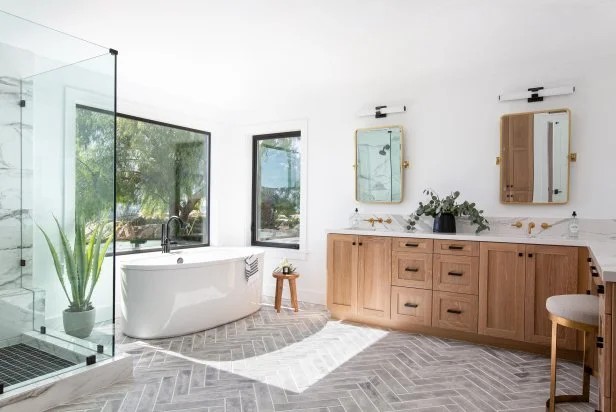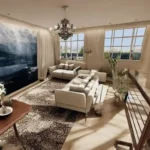Bathrooms today are designed with purpose.
They’re calm, functional spaces that balance utility with atmosphere.
Every element, whether it’s light, sound, layout, or texture, works together to create an environment that feels effortless.
The new essentials are all about precision and thoughtful detail that make the space flow naturally.
Modern bathroom design values experience over trend.
As such, they’re integrating comfort, technology, and sustainability that feel timeless.
The essentials have moved from visual appeal to daily usability, and the smartest upgrades are those that quietly improve how the room feels and performs.
Let’s discuss this further below:
Creating a Well-Planned Layout
A well-designed layout defines how a bathroom works.
Placement of fixtures, lighting, and storage affects everything, from comfort to the sense of space.
The modern approach favors clarity: open zones, accessible pathways, and proportions that make small spaces feel larger without losing warmth.
Working with a bathroom remodeling company helps bring structure to the vision.
Professionals understand how to balance plumbing, lighting, and design flow, ensuring that every inch has a purpose.
The result is a bathroom that functions with precision and feels naturally balanced day after day.
Integrating Ventilation Systems
Ventilation is one of the most overlooked yet critical components of a bathroom.
Modern systems do more than remove steam, as they protect surfaces, prevent mold, and maintain air clarity without creating noise or visual clutter.
Integration begins at the planning stage, built to work invisibly and effectively.
Quiet fans, smart sensors, and hidden vents are becoming standard.
They keep the air fresh, preserve finishes, and make long-term maintenance simple.
The best designs treat ventilation as part of the architecture, not an afterthought.
Blending Mirrors and Lighting
Lighting and mirrors shape how a bathroom feels. Together, they define visibility, depth, and mood.
Layered lighting, let’s say, task, ambient, and accent, creates zones that shift naturally from morning routines to evening relaxation.
Mirrors amplify that effect, doubling light while softening the room’s edges.
In modern spaces, the goal is balanced illumination.
Warm light paired with clean reflection turns the bathroom into a place of ease rather than glare.
Most homeowners want lighting that flatters, not floods, and mirrors that enhance without overwhelming.
Using Modern Tiling Patterns
Tiles have moved beyond standard grids.
Today’s bathrooms play with geometry, size, and texture to add movement and personality.
Large-format tiles make small spaces feel expansive, while patterns like herringbone or stacked lines create quiet visual rhythm.
The modern approach focuses on subtle impact, like tones that connect, materials that last, and layouts that add structure without noise.
Texture and scale are the new design language, shaping bathrooms that feel contemporary yet calm.
Including Quiet-Close Cabinetry and Drawers
Every sound in a bathroom affects how calm the space feels.
Quiet-close drawers and cabinets replace abrupt motion with fluid precision.
They extend the lifespan of the hardware while creating an atmosphere that feels intentional and soft.
Apart from noise control, this design choice elevates usability.
Sleek lines, flush panels, and concealed handles bring uniformity, while interior organization systems make daily routines smoother.
Balancing Privacy with Openness
Modern bathroom design aims for openness without losing comfort.
The challenge lies in creating a space that feels bright and connected while still maintaining personal boundaries.
This balance often comes through thoughtful zoning, that is, partial walls, frosted glass, and subtle shifts in material contrast that define space without closing it off.
The goal is to design a layout that feels expansive, not exposed.
Transparency is treated as a design tool rather than a risk.
Natural light flows through partitioned glass, and visual separation happens through texture instead of heavy structure.
It’s a quiet sophistication that gives the bathroom a spa-like openness while still keeping private areas discreet. The best designs make privacy feel effortless.
Improving Acoustics
Most homeowners might not realize this, but sound is one of those things that can make or break the entire bathroom experience.
When you enter a bathroom, you expect privacy, and sound coming from outside will make this hard to achieve.
Likewise, if you enter a bathroom and it is completely silent, your body will automatically go into relaxation mode.
Hard surfaces like pebble tile and glass can amplify echoes, turning a relaxing space into one that feels cold and sharp.
Modern bathroom design treats acoustics as part of the sensory experience, using materials and layouts that soften sound.
Acoustic insulation in walls, under floors, and even behind cabinetry can make a dramatic difference.
Adding texture with rugs, wood elements, or matte finishes helps absorb excess sound. The result is a bathroom that feels still, calm, and balanced.
Silence becomes part of the design, shaping a space that genuinely feels restorative from the moment you enter.
Adding Statement Fixtures
Today’s bathrooms often include a single focal point that defines character, something sculptural, bold, or beautifully crafted.
It could be a freestanding tub, a striking faucet, or a lighting fixture that turns function into art. Such statement pieces don’t compete with the space.
What makes a fixture stand out now isn’t size or cost, but purpose.
It ties the room together and gives it personality without clutter.
Matte black taps, minimalist lighting, and organic-shaped basins have become the new icons of contemporary design.
They serve as reminders that elegance can exist in restraint.
Selecting Eco-Friendly Finishes
Sustainability is a given.
Homeowners are choosing materials that are renewable, durable, and low-maintenance.
Recycled glass tiles, bamboo cabinetry, and water-efficient fixtures define this new standard of mindful design. Most of these elements reflect responsibility.
Choosing eco-friendly finishes also improves indoor quality.
Low-VOC paints, natural stone sealants, and energy-saving lighting create a healthier environment that lasts.
Modern bathrooms are no longer built around experience.
The new essentials focus on simplicity, comfort, and awareness.
Every feature, from quiet cabinetry to natural light and sound control, contributes to an atmosphere that restores rather than overwhelms.
Working with professionals who understand this balance turns ideas into real, livable spaces.
The details, whether ventilation, layout, or finishes, come together to create something lasting.



